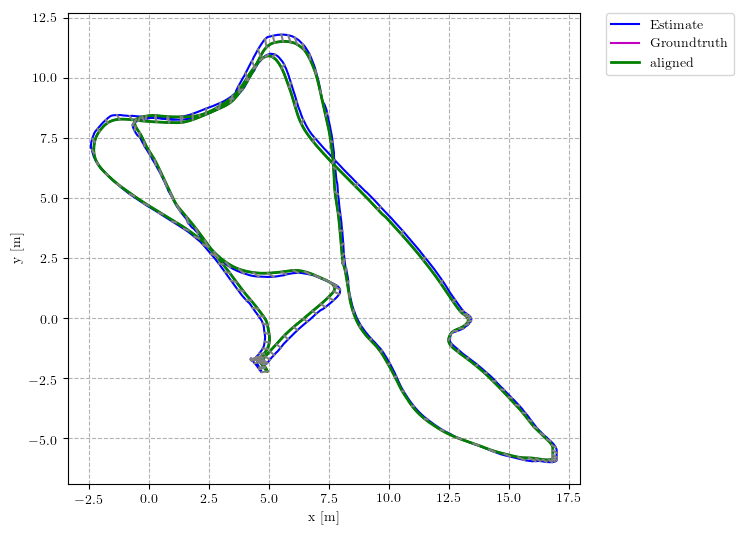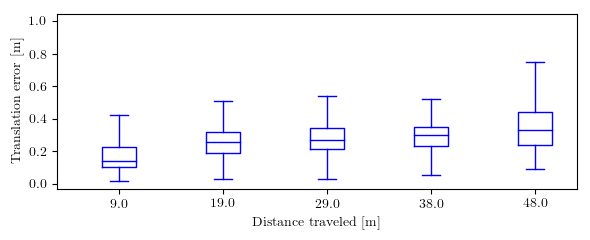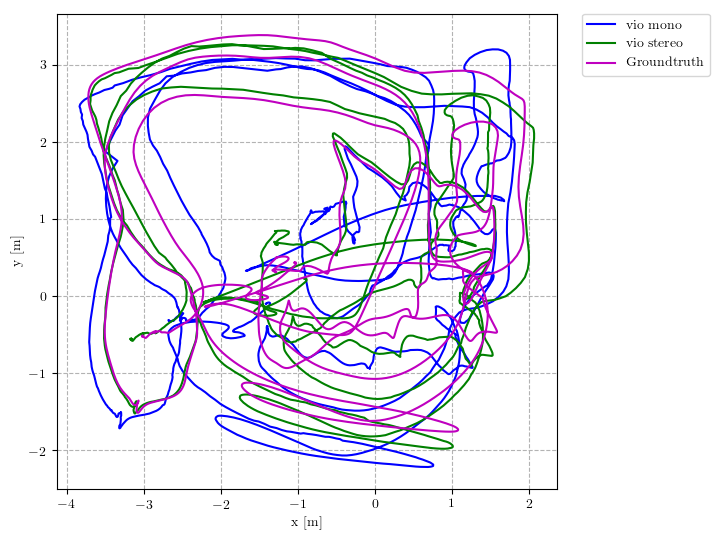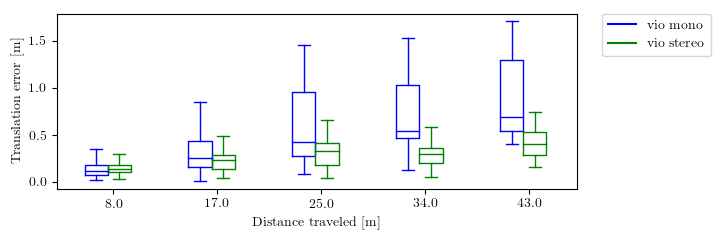This repository implements common used trajectory evaluation methods for visual(-inertial) odometry. Specifically, it includes
- Different trajectory alignment methods (rigid-body, similarity and yaw-only rotation)
- Commonly used error metrics: Absolute Trajectory Error (ATE) and Relative/Odometry Error (RE)
Since trajectory evaluation involves many details, the toolbox is designed for easy use. It can be used to analyze a single trajectory estimate, as well as compare different algorithms on many datasets (e.g., this paper) with one command. The user only needs to provide the groundtruths and estimates of desired format and specify the trajectory alignment method. The toolbox generates (almost) paper-ready plots and tables. In addition, the evaluation can be easily customized.
If you use this code in an academic context, please cite the following paper:
Zichao Zhang, Davide Scaramuzza: A Tutorial on Quantitative Trajectory Evaluation for Visual(-Inertial) Odometry, IEEE/RSJ Int. Conf. Intell. Robot. Syst. (IROS), 2018.
@InProceedings{Zhang18iros,
author = {Zhang, Zichao and Scaramuzza, Davide},
title = {A Tutorial on Quantitative Trajectory Evaluation for Visual(-Inertial) Odometry},
booktitle = {IEEE/RSJ Int. Conf. Intell. Robot. Syst. (IROS)},
year = {2018}
}
The package is written in python and tested in Ubuntu 16.04 and 18.04.
Currently only python2 is supported.
The package can be used as a ROS package as well as a standalone tool.
To use it as a ROS package, simply clone it into your workspace.
It only depends on catkin_simple to build.
Dependencies: You will need numpy and matplotlib for the analysis/plotting.
Each trajectory estimate (e.g., output of a visual-inertial odometry algorithm) to evaluate is organized as a self-contained folder. Each folder needs to contain at least two text files specifying the groundtruth and estimated poses with timestamps.
stamped_groundtruth.txt: groundtruth poses with timestampsstamped_traj_estimate.txt: estimated poses with timestamps- (optional)
eval_cfg.yaml: specify evaluation parameters
You can see the folders under results for examples.
These three files contains all the essential information to reproduce quantitative trajectory evaluation results with the toolbox.
The groundtruth and estimated poses are specified in the following format
# timestamp tx ty tz qx qy qz qw
1.403636580013555527e+09 1.258278699999999979e-02 -1.561510199999999963e-03 -4.015300900000000339e-02 -5.131151899999999988e-02 -8.092916900000000080e-01 8.562779200000000248e-04 5.851609599999999523e-01
......
Note that the file is space separated, and the quaternion has the w component at the end.
The timestamps are in the unit of second and used to establish temporal correspondences.
There are some scripts under scripts/dataset_tools to help you convert your data format (EuRoC style, ROS bag) to the above format.
See the corresponding section below for details.
Currently eval_cfg.yaml specifies two parameters for trajectory alignment (used in absolute errors):
align_type:sim3: a similarity transformation (for vision-only monocular case)se3: a rigid body transformation (for vision-only stereo case)posyaw: a translation plus a rotation around gravity (for visual-inertial case)none: do not align the trajectory
align_num_frames: the number of poses (starting from the beginning) that will be used in the trajectory alignment.-1means all poses will be used.
If this file does not exist, trajectory alignment will be done using sim3 and all the poses.
We can run the evaluation on a single estimate result or for multiple algorithms and datasets.
As a ROS package, run
rosrun rpg_trajectory_evaluation analyze_trajectory_single.py <result_folder>
or as a standalone package, run
python2 analyze_trajectory_single.py <result_folder>
<result_folder> should contain the groundtruth, trajectory estimate and optionally the evaluation configuration as mentioned above.
After the evaluation is done, you will find two folders under <result_folder>:
saved_results: text files that contains the statistics of different errorsabsolute_err_statistics_<align_type>_<align_frames>.yaml: the statistics of the absolute error using the specified alignment.relative_error_statistics_<len>.yaml: the statistics of the relative error calculated using the sub-trajectories of length<len>.cached_rel_err.pickle: since the relative error is time consuming to compute, we cache the relative error for different sub-trajectory lengths so that we can directly use them next time.
plots: plots of absolute errors, relative (odometry) errors and the trajectories.
Several example plots showing the trajectory, absolute trajectory error and relative error are
--recalculate_errors: will remove the error cache file mentioned above and re-calculate everything. Default:False.--png: save plots as png instead of pdf. Default:False
For ROS, run
rosrun rpg_trajectory_evaluation analyze_trajectories.py \
--platform <platform> --odometry_error --overall_odometry_error --plot_trajectories --rmse_table
otherwise, run
python2 analyze_trajectories.py \
--platform <platform> --odometry_error --overall_odometry_error --plot_trajectories --rmse_table
These commands will look for <platform> folder under results and analyze the algorithms and datasets combinations specified in analyze_trajectories.py, as described below.
The datasets under results are organized as
<platform>
├── <alg1>
│ ├── <platform>_<alg1>_<dataset1>
│ ├── <platform>_<alg1>_<dataset2>
│ └── ......
└── <alg2>
│ ├── <platform>_<alg2>_<dataset1>
│ ├── <platform>_<alg2>_<dataset2>
├── ......
......
Each sub-folder is of the same format as mentioned above.
In the script analyze_trajectories.py, you need to specify the algorithms and datasets to analyze, for example
ALGORITHM_CONFIGS = ['vio_mono', 'vio_stereo']
DATASETS = ['MH_01', 'MH_03', 'MH_05', 'V2_01', 'V2_02', 'V2_03']
PLOT_LABELS = {'vio_mono': 'vio mono', 'vio_stereo': 'vio stereo'}will analyze the following folders
├── vio_mono
│ ├── laptop_vio_mono_MH_01
│ ├── laptop_vio_mono_MH_03
│ ├── laptop_vio_mono_MH_05
│ ├── laptop_vio_mono_V2_01
│ ├── laptop_vio_mono_V2_02
│ └── laptop_vio_mono_V2_03
└── vio_stereo
├── laptop_vio_stereo_MH_01
├── laptop_vio_stereo_MH_03
├── laptop_vio_stereo_MH_05
├── laptop_vio_stereo_V2_01
├── laptop_vio_stereo_V2_02
└── laptop_vio_stereo_V2_03
Optionally, you can change the following variables in the script for more customization
COLORS: a dictionary specifying the colors for different algorithms. A set of default colors will be generated.MAX_TRAJ_LENGTHS: a dictionary specifying the maximum trajectory lengths of datasets. If there is no entry for one dataset, the maximum length will be computed from the groundtruth.OVERALL_BOXPLOT_DISTANCES: sub-trajectory lengths used to evaluate the relative errors on all the datasets to compute the overall relative error.
The evaluation process will generate the saved_results folder in each result folder,
same as the evaluation for single trajectory estimate.
In addition, it will generate plots and text files under results folder comparing different algorithms:
<dataset>_trajectory_side/top.pdf: plots of the aligned trajectories of different algorithms on<dataset>, along with the groundtruth.<dataset>_translation/yaw_error.pdf: plots of the relative translation and yaw error of different algorithms on<dataset>.overall_rel_trans/yaw_error.pdf: plots of the overall relative error of different algorithms evaluated on all datasets.overall_rel_trans/yaw_err.txt: tables of the relative error of different algorithms evaluated on all datasets.<platform>_translation_rmse.txt: table of the translation RMSE (absolute trajectory error) of all datasets and algorithms.
The tables can be readily used in Latex files.
Several example plots comparing the performance of different algorithms are
Paths:
--results_dir: the folder where the<platform>folder will be found. Default:resultsfolder in the toolbox folder.--output_dir: the folder for all the plots and text files. Default:resultsfolder in the toolbox folder.
Which trajectory estimate to process:
--platform: the folder of results to be found under the<results_dir>. Default:laptop--alg: which algorithm to process. Default:all, will process all the algorithms specified in the script.--dataset: which dataset to process. Default:all, will process all the datasets specified in the script.
Analysis options:
--odometry_error_per_dataset: whether to compute the relative error for each dataset. Default:False.--overall_odometry_error: whether to compute the overall relative error on all the datasets. Default:False.--rmse_table: whether to generate the table of translation RMSE (absolute error). Default:False.--plot_trajectories: whether to plot trajectories. Default:False.
Misc:
--recalculate_errors:whether to clear the cache and recalculate everything. Default: False.--png: save plots as png instead of pdf. Default:False
Under scripts/dataset_tools, we provide several scripts to prepare your dataset for analysis. Specifically:
asl_groundtruth_to_pose.py: convert EuRoC style format to the format used in this toolbox.bag_to_pose.py: extractPoseStamped/PoseWithCovarianceStampedin a ROS bag to the desired format.transform_trajectory.py: transformed a pose file of our format by a given transformation, useful for applying hand-eye calibration to groundtruth/estimate before analysis.
Most of the error computing is done via the class Trajectory (src/rpg_trajectory_evaluation/trajectory.py).
If you would like to customize your evaluation, you can use this class directly.
The API of this class is quite simple
# init with the result folder.
# You can also specify the subtrajecotry lengths and alignment parameters in the initialization.
traj = Trajectory(result_dir)
# compute the absolute error
traj.compute_absolute_error()
# compute the relative errors at `subtraj_lengths`.
traj.compute_relative_errors(subtraj_lengths)
# compute the relative error at sub-trajectory lengths computed from the whole trajectory length.
traj.compute_relative_errors()
# save the relative error to `cached_rel_err.pickle`
traj.cache_current_error()
# write the error statistics to yaml files
traj.write_errors_to_yaml()
# static method to remove the cached error from a result folder
Trajectory.remove_cached_error(result_dir)After the error is computed, the absolute and relative errors are stored in the trajectory object and can be accessed afterwards:
-
absolute error:
traj.abs_errors. It is a dictionary stores the absolute errors of all poses as well as their statistics. SeeTrajectory.compute_absolute_errorfunction for details. -
relative error:
traj.rel_errors. It is a dictionary stores the relative errors of different distances (using the distance as the key). SeeTrajectory.compute_relative_error_at_subtraj_lenfunction for details.
With the interface, it should be easy to access all the computed errors for customized analysis.
See package.yaml for the list of authors that have contributed to this toolbox.
It might happen that some open-source code is incorporated into the toolbox but we missed the license/copyright information. If you recognize such a situation, please open an issue.




